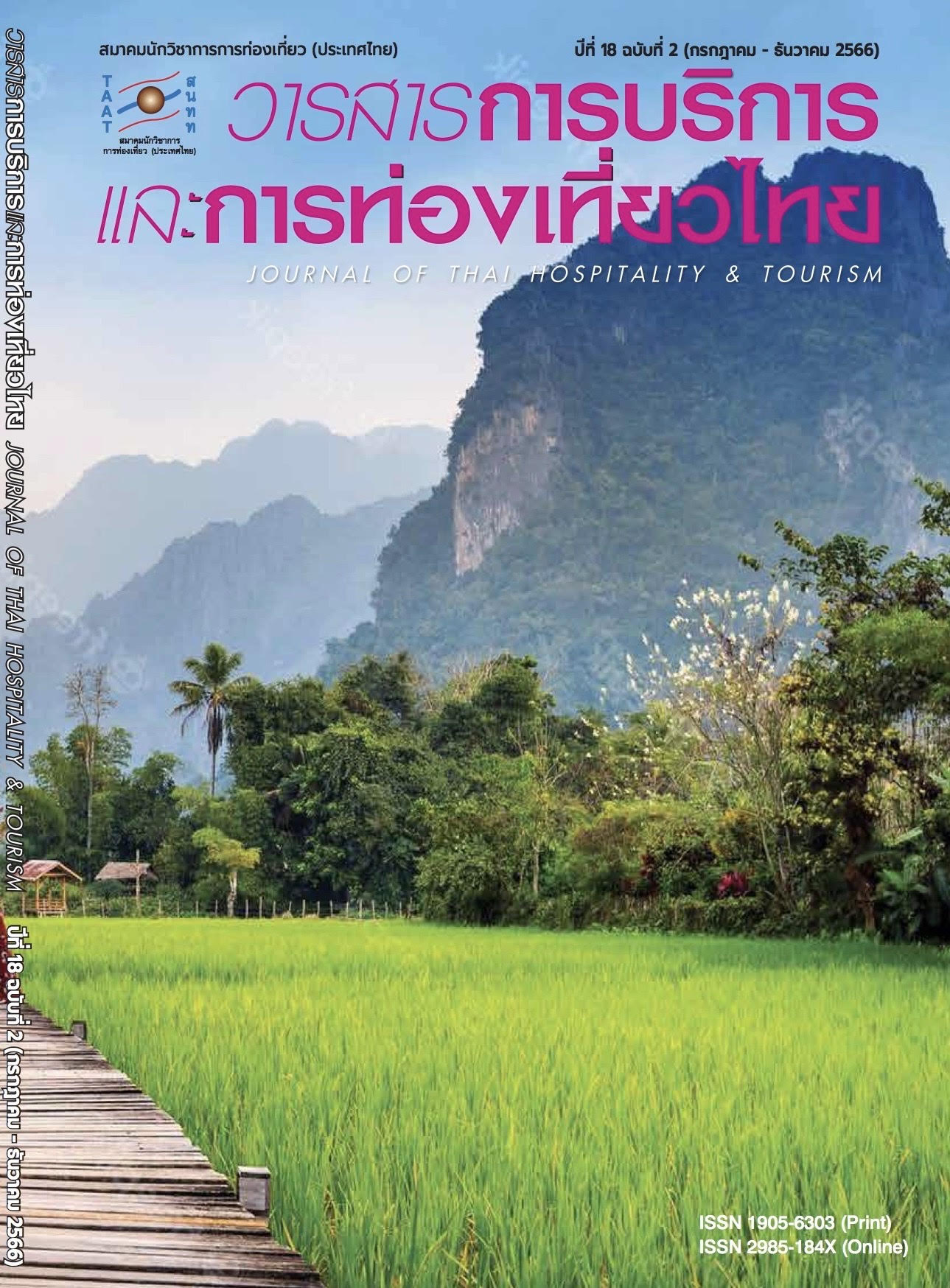รูปแบบการจัดการขีดความสามารถในการรองรับนักท่องเที่ยวของเขตห้ามล่าสัตว์ป่าดูนลำพัน จังหวัดมหาสารคาม
Main Article Content
บทคัดย่อ
การวิจัยนี้ มีวัตถุประสงค์เพื่อศึกษารูปแบบการจัดการขีดความสามารถในการรองรับนักท่องเที่ยวที่เหมาะสมต่อเขตห้ามล่าสัตว์ป่าดูนลำพัน จังหวัดมหาสารคาม ใช้วิธีวิจัยแบบผสมผสานโดยรวมการวิจัยเชิงคุณภาพ จากการลงพื้นที่ภาคสนามและการประเมินพื้นที่ และการวิจัยเชิงปริมาณ จากการสำรวจความคิดเห็นของนักท่องเที่ยวจากกลุ่มตัวอย่าง 353 คน
ผลการวิจัยพบว่า รูปแบบการจัดการขีดความสามารถในการรองรับนักท่องเที่ยวที่เหมาะสมต่อเขตห้ามล่าสัตว์ป่าดูนลำพัน จังหวัดมหาสารคาม มีองค์ประกอบดังนี้ 1) ขีดความสามารถในการรองรับทางกายภาพที่เหมาะสม 2,628,000 คน/ปี 2) ขีดความสามารถในการรองรับที่แท้จริงที่เหมาะสม 152,562 คน/ปี 3) มีขีดความสามารถในการรองรับที่มีประสิทธิผลที่เหมาะสม 61,028 คน/ปี 4) ขีดความสามารถในการรองรับนักท่องเที่ยวของพื้นที่ระดับความรู้สึกแออัดอยู่ในระดับ Below CC และ 5) ขีดความสามารถในการรองรับด้านจิตวิทยาระดับความรู้สึกแออัดอยู่ในระดับ Below CC
Article Details

อนุญาตภายใต้เงื่อนไข Creative Commons Attribution-NonCommercial-NoDerivatives 4.0 International License.
เอกสารอ้างอิง
Buakwan, N., Chaiyakot, P. & Suwanvong, D. (2016). Community-Based Tourism Management in Five Southern Border Province (Satun, Songkhla, Pattani, Yala, and Narathiwat) and Four States (Kelantan, Perak, Kedah, and Perlis) of Malaysia under Community Based Tourism Standard to ASEAN. Thailand Research Fund.
Creswell, J. W. (2009). Research Design: Qualitative, Quantitative, and Mixed Methods Approaches. Sage Publication.
Department of Tourism (DOT). (2014). A Guide to Assessing Quality Standards of Natural Attractions. DOT.
Doon Lamphun Non-Hunting Area Office. (2020). Information of Doon Lamphun Non-Hunting Area. https://www.m-culture.go.th/mahasarakham/ewt_news.php?nid=1124&filename=index
Duangsaeng, V. (2019). Psychological Carrying Capacity in Recreation Aspects of Tourism Attractions in Doi Inthanon National Park. The Journal of Human Sciences, 20(3), 200–234.
Esichaikul, R. (2014). Niche Tourism Management. Sukhothai Thammathirat Open University.
Glasson, J., Godfrey, K. & Goodey, B. (1995). Towards Visitor Impact Management: Visitor Impacts, Carrying Capacity, and Management Responses in Europe’s Historic Towns and Cities. Brookfield.
Koment, J. et al. (2020). The Development of Criteria and Regulations for Ecotourism Management Based on Biodiversity and Bioconservation of the Community Based Social Enterprise. Journal of Thai Hospitality and Tourism, 15(2), 93–104.
Liburd, J. J. & Becken, S. (2017). Values in Nature Conservation, Tourism and UNESCO World Heritage Site Stewardship. Journal of Sustainable Tourism, 22(4), 646–665.
Maha Sarakham Provincial Tourism and Sports Office. (2021). Doon Lamphun Non-Hunting Area. https://province.mots.go.th/ewtadmin/ewt/mahasarakham/news_view.php?nid=365
Maldonado, E. (2004). Carrying Capacity of La Tigra National Park, Honduras: Can the Park Be Self-Sustainable. Journal of Sustainable Forestry, 19(4), 29–39.
Manning, R. E. & Lawson, S. R. (2002). Carrying Capacity as “Informed Judgment”: the Values of Science and the Science of Values. Environmental Management, 30(2), 157–168.
Martin, M. & Ian, M. (2009). Tourism and Sustainability Development Globalization and New Tourism in the Third World. Routledge.
Ministry of Tourism and Sports (MOTS). (2016). Project for Sustainable Tourism Promotion. https://mots.go.th/ewt_dl_link.php?nid=12288
Ministry of Tourism and Sports (MOTS). (2017). National Tourism Development Plan, Vol.2 (2017-2021). Office of Printing Works of the War Veterans Organization.
Na Thongkaew, B. (2015). Carrying Capacity for Community-Based Tourism at Koh Phithak, Chumphon Province Phases II. Area Based Development Research Journal, 6(4), 79–93.
Rogers, E. M. (2010). Diffusion of Innovations. Simon and Schuster.
Sangpikul, S. (2013). Research Methods in Tourism and Hospitality. Dhurakij Pundit University.
Scott, D., Hall, C. M & Gössling, S. (2016). A Report on the Paris Climate Change Agreement and Its Implications for Tourism: Why We Will Always Have Paris. Journal of Sustainable Tourism, 24(7), 933–948.
Swarbrooke, J. (1999). Sustainable Tourism Management. CABI Publishing.
United Nations Economic and Social Commission for Asia and the Pacific (UNESCAP). (2006). Economic and Social Survey of Asia and the Pacific 2006. https://www.unescap.org/publications/economic-and-social-survey-asia-and-pacific-2006-energizing-global-economy#
United Nations Environment Programme & World Trade Organization (UNEP & WTO). (2005). Making Tourism More Sustainable: A Guide for Policy Makers. https://wedocs.unep.org/20.500.11822/8741
United Nations Environment Programme (UNEP). (1997). World Environment Day Honours Twenty-Fifth Anniversary of the United Nations Environment Programme. http://www.un.org/press/en/1997/19970529.unep5.html
Wongsawat, S., Keawuthai, K., Thaithong, N., Khunrit, M. & Phromana, J. (2020). The Psychological Carrying Capacity of Tourism in Ban Namrad Water-Source Forest, Bann Tumneab Sub-District, Suratthani Province. Suratthani Rajabhat Journal, 7(2), 219–258.
World Tourism Organization (UNWTO). (2017). Tourism and the Sustainable Development Goals – Journey to 2030. UNWTO.
Yamane, T. (1973). Statistics: An Introductory Analysis. Harper and Row.
Zelenka, J. & Kaceti, J. (2014). The Concept of Carrying Capacity in Tourism. Economic Interferences, 16(36), 641–645.


